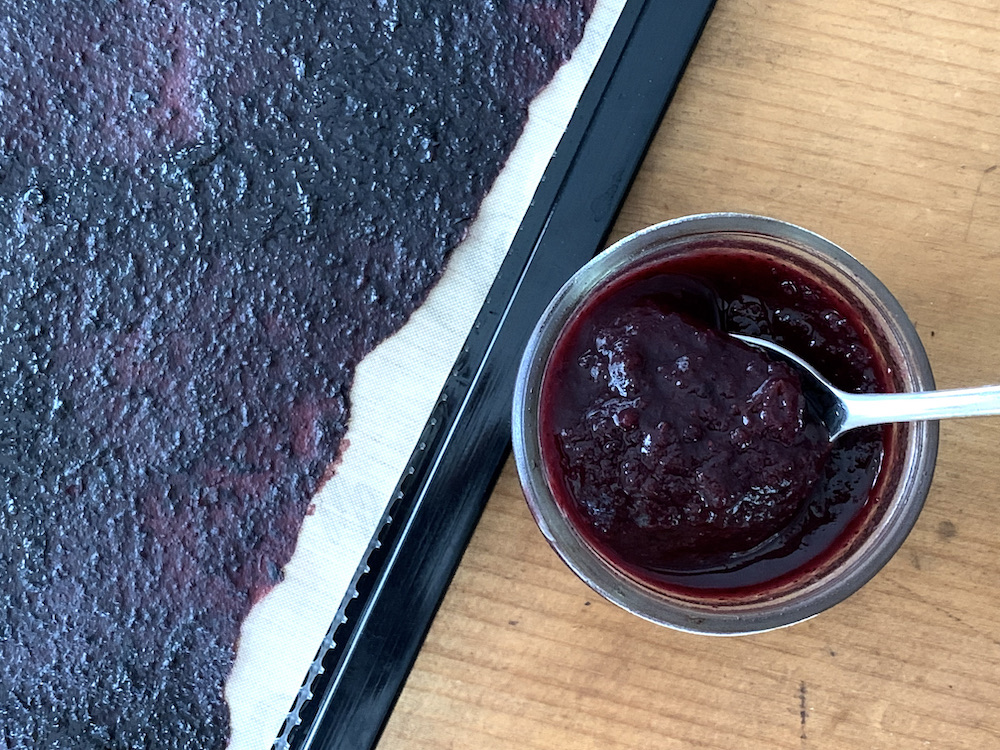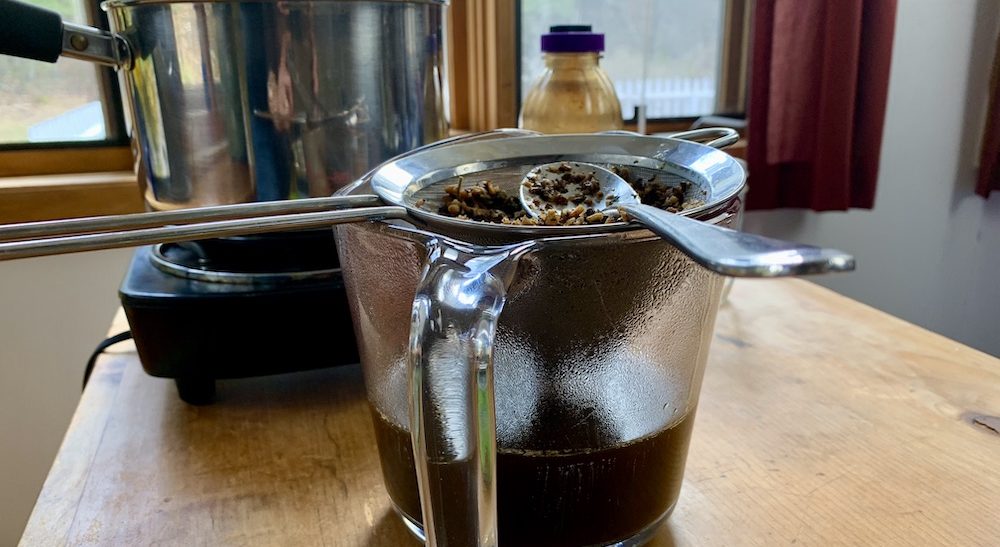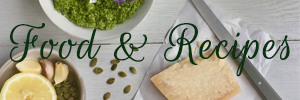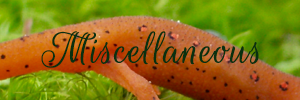There are many ways to make herbal syrups, but this particular technique involves simmering and then concentrating down your herbs, fruit, or mushrooms to make a dense, potent extract. Adding some kind of sweetener at the end officially turns it into a syrup, but you could also leave the sweetener out and simply freeze it in ice cube trays for later use. You could also mix it with applesauce or other pectin-rich sauce to dehydrate like a fruit leather.
Watch the Video Below and then Read on For More Information!
Why Syrup?
I’ll admit, syrups aren’t always my first choice for herbal remedies for a few reasons (more on that later) but they do have some substantial benefits:
- Alcohol-Free: Great for those avoiding alcohol entirely and those who want to add more herbs to their current routine while keeping alcohol to a minimum. They’re easier to incorporate into foods like smoothies, coffee, golden milk, tea, or simply take by the spoonful.
- Highly Concentrated and Convenient: Because of the concentrating process (simmering it uncovered to evaporate much of the liquid), you can fit a lot of medicinal activity into just one spoonful of extract. Much more than you’d get from a tincture, and often more than a cup of tea. And it’s a lot easier (once you have it made) than making a decocted (simmered) tea from scratch every morning.
- Superior for Minerals and Polysaccharides: These constituents extract better via decoction (simmering) while tinctures (alcohol) don’t extract these particular constituents well at all.
- Sweet = Tastier: More palatable, especially for picky peeps.
What Herbs Work Best
Because we’ll be subjecting our plant or mushroom material to hours of simmering, we’ll stick to those that can 1. Withstand all that simmering without losing vitality and potency, and often 2. Become more medicinal and bioavailable when simmered.
Mineral-Rich Herbs
Minerals like calcium, magnesium, and iron are best extracted from herbs via decoction. Think of minerals as rock-like substances imbedded in the plant matrix – it takes effort to coax them into solution, and they do not dissipate easily. Blackstrap molasses is a worthy sweetener for mineral-rich blends because it itself is relatively high in calcium, magnesium, and iron, sometimes containing 10-20% of the RDA per spoonful (check the label to see how your particular brand stacks up).
Calcium supports bone strength, muscle contraction, a more alkaline pH balance, healthy blood pressure, and electrolyte balance. Deficiency can lead to osteoporosis, bone loss, aches and pains after exertion, tooth degradation, and growing pains. Recommended Daily Allowance (RDA) 1,000 mg daily, 1,200 for elders and post menopause
Magnesium promotes cellular energy metabolism, heart health, muscle relaxation, nerve function and relaxation, blood pressure balance, bone support. Deficiency, which is common, can increase muscle spasms, cramps, ticks, anxiety, migraines, bone loss, constipation. RDA 400 mg daily, though some people do well with higher amounts
Potassium balances sodium to help maintain low blood pressure, acts as an important electrolyte, supports cardiovascular health and bone formation, and is an important co-factor in many body processes. Deficiency can cause electrolyte imbalance, fatigue, muscle cramps, intestinal disturbance, and in extreme cases potentially fatal cardiovascular problems. RDA 4,700 mg daily
Silica supports various types of connective tissue matrix including collagen, cartilage, bones, hair, skin, nails, elastin, and keratin to improving not only strength but also flexibility and resilience. Deficiency can lead to brittle bones and nails, poor skin health and wrinkles, and reduced hair vitality. No established RDA.
Iron helps to enrich the blood so that it’s better able to hold oxygen for cellular energy. Deficiency can cause anemia, with symptoms that include deep fatigue, heart and breathing issues, anxiety, depression, and pale skin. Most important for those experiencing blood loss, such as from heavy menstrual bleeding. Excessive amounts can be harmful, especially for heart health. RDA 18 mg.
Top Mineral-Rich Herbs at a Glance
The mg of mineral is given approximately per ounce by weight of herb, calculated primarily from Jim Duke’s Phytochemical database highest ranges tested.
- Nettle spring leaves (Urtica dioica) 825 mg calcium; 245 mg magnesium; 500 mg potassium
- Dandelion leaf (Taraxacum officinale) 1,200 mg calcium; 850 mg potassium; 25 mg iron
- Dandelion root (Taraxacum officinale) 340 mg potassium; 3 mg iron
- Horsetail (Equisetum arvense) 535 mg calcium; 125 mg magnesium; 2,750 mg silica
- Oat straw (Avena sativa) 405 mg calcium; 340 mg magnesium; 75 mg potassium; 1,020 mg silica
- Burdock root (Arctium lappa) 150 mg magnesium; 4 mg iron
- Horsetail (Equisetum arvense) (125 mg)
- Red Clover flowers (Trifolium pratense) 370 mg calcium; 100 mg magnesium; 565 mg potassium
- Yellow Dock root (Rumex crispus) 2 mg iron (but also encourages iron release from storage into bloodstream)
- Cacao Nibs (Theobroma cacao) 150 mg magnesium
- Alfalfa leaf (Medicago sativa) 255 mg calcium
Mushrooms & Polysaccharide-Rich Herbs
There are a few reasons why mushrooms should be cooked, even better if simmered. First, mushroom fruiting bodies contain a tough fiber called chitin in their cellular matrix. The is the same substance that makes shellfish shells hard, and in mushrooms it prevents us from utilizing key constituents like immune-supportive polysaccharides. Gently simmering mushrooms for several hours or even days helps break that matrix down; grinding or powdering the mushrooms first greatly enhances the process. Second, polysaccharides themselves are particularly water-soluble and extract well via long, gentle simmering. Lastly, most otherwise safe edible and medicinal mushrooms are moderately toxic or upset the stomach if consumed raw, but are not a problem once cooked because this breaks down some of the problematic constituents. (This only applies for our otherwise safe mushrooms! If you cook a toxic mushroom, it’s still toxic.) I’m particularly fond of reishi mushroom in syrup, though turkey tails, and shiitake are also excellent candidates. Chaga makes an excellent syrup, but I have stopped using this wildcrafted gungus due to sustainability concerns.
Polysaccharides are complex fiber-like starches found in medicinal mushrooms as well as some herbs. When consumed regularly, they support the body’s immune system. I like to think of them as sending the immune system back to boot camp. Regular polysaccharide consumption encourages better signaling and communication, formation of immune cells, and healthy response to infections and pathogens while simultaneously down-regulating allergies and autoimmune disease in most people. (That said, if you experience a flare-up from mushrooms or polysaccharide-rich herbs, listen to your body. Not everyone tolerates them. Some people have specific sensitivities to mushrooms, too, but may be fine with herbs like astragalus.) Polysaccharide-rich herbs don’t contain chitin and therefore don’t need to as much effort to extract the constituents as mushrooms, but they still do nicely when simmered. Our most prominent polysaccharide-rich immune herb is astragalus root (Astragalus propinquus, syn. A. membranaceus).
Alterative, Detoxification Support Herbs
Many of our roots and barks that support gentle system-wide body detoxification extract well and hold up nicely when simmered, such as dandelion root and leaf, burdock root, chicory root, and nettle leaf. These herbs support the liver in particular as well as lymph and kidney health. They’re moderately bitter, which helps stimulate healthy digestive function, bile production, fat digestion, blood sugar balance (less so in a sweet base), and appetite regulation. You might recognize these herbs as also being nutritive. Chicory (Cichorium intybus) is closely related to dandelion and offers similar though perhaps gentler actions and nutrition. It’s popularly roasted to brew up like coffee and lends a nice coffee-like flavor to syrups, which can make the bitter flavors of the alterative herbs as well as reishi mushroom more palatable, especially if blackstrap molasses is used as the sweetener.
Mucilaginous Herbs
Related to polysaccharides, mucilage contains complex starches called mucopolysaccharides. Demulcent, mucilaginous herbs tend to develop a thick slimy or velvety consistency in water and are soothing to dry, irritated, or damaged mucous membranes such as the throat and gastrointestinal tract. They even soothe tissues that they don’t come directly in contact with, such as the lungs and urinary tract. Marshmallow root (Althaea officinalis), marshmallow and mallow leaves (Malva species), slippery elm bark (Ulmus rubra), Irish moss, aloe inner gel, and prickly pear cactus are exceptionally high in mucilage. I tend to use marshmallow roots and leaves most often because they’re so readily available, affordable, and sustainable. I generally avoid slippery elm due to sustainability concerns and am cautious with aloe because even though the inner gel is quite safe, the latex (just under the skin) of the leaves contains harsh laxative and moderately toxic and cancer-promoting constituents. Technically, mucilage extracts best in long, cold-water extractions. Simmering it will at least temporarily break the mucilage bonds, but I personally believe that they’re still beneficial and acceptable in a decocted syrup or concentrate, much in the same way that gelatin in bone broth temporarily liquifies when heated, re-congeals when cold, and is still beneficial hot or cold.

Fruit & Berries
Although we definitely lose vitamin C and possibly a few other constituents, many of our pigments and beneficial bioflavonoids in berries and fruit – not to mention gelatinous and pre-biotic pectin (a soluble fiber) – will withstand the heat, and this method allows for the high dose without the alcohol that we usually want from these functional foods. The method for making a fruit or berry concentrate is a tad different from the rest that are described in this article. Typically, we simmer whole fruit and juice uncovered, mashing fruit up as it simmers for an hour or two, leaving uncovered to reduce the water content. Then you can strain for a more runny syrup or (even better??) run it through a food mill to remove any seeds (such as apple, hawthorn) and maintain a more saucy consistency. The concentrated juice also serves as a sweetener, though you could add honey, sugar, or glycerine to it, too. jim mcdonald has a great apple-berry concentrate recipe online and in the book Wild Remedies* (as well as the 2022 blog and video jim did for Mountain Rose Herbs here!) that features this technique. that is often made with apple cider or juice, blueberries, and hawthorn berries, but you can certainly mix it up with other fruits and berries (cranberry, rosehip – strain hairs well if you aren’t using store-bought, wild grapes, aronia berries, pomegranate, tart cherry…).
The process is typically three steps: 1. simmer juice + fruit uncovered for 1-2 hours until volume is reduced by half (make sure not to burn), 2. strain or run through food mill and return to pot, 3. simmer uncovered until reduced to half the volume (make sure it doesn’t burn). As with other syrup concentrates, this is not shelf stable. It keeps about for at least a week or two in the fridge (maybe months? no promises!), store extras in small jars in the freezer, or…
Tip – Fruit Concentrate Leather: I’ have added chunks of apples to my simmering recipe in step 1 (which turns into applesauce – the pectin is perfect for fruit leather), I run the concentrate through a food mill, concentrate further, then dehydrate the concentrated as fruit leather. It’s pretty fabulous. I use a dehydrator with a fruit leather tray (parchment paper works, too), set at about 130 degrees F. Remove from the sheet while it’s still warm and pliable, let cool, roll in waxed paper, then cut into strips and store in an airtight container in a cool, dark, dry spot. (If you don’t have a dehydrator, you can try using silicone or parchment-covered baking sheets in the oven at the lowest setting with the door propped open. I haven’t done this personally.)
Anything Else that Withstands Simmering
Any other herb that is extracted well and/or can withstand long-term simmering is acceptable in a concentrated syrup. This includes antioxidant-rich berries like blueberries (great for blood vessel health and vision!), hawthorn berries, flowers, and leaves (heart tonic), elderberries (immune support), spices including ginger, turmeric (instant golden milk? Oh yeah!), garlic, onions, elecampane root, adaptogens like ashwagandha, codonopsis, and schizandra, and most medicinal roots and barks.

The Process
- 1. If desired, measure your starting plant/mushroom material by weight first (this will allow you to calculate how much herb per dose you get in your final extract). Grinding is not essential but will make a stronger extract. Completely cover in water, put a lid on the pot, bring to a boil then reduce to a gentle simmer. Simmer for 20 minutes to several hours (or days, for mushrooms, if desired). Feel free to do this in a pot on the stove or in a crock pot. Check and stir periodically, adding more water if needed to keep the herb/mushroom covered.
- 2. Straight out your herbs through a fine mesh strainer or clean cloth, squeezing out as much tea as possible. If desired, measure the volume of liquid/tea.
- 3. Clean out the pot, add the strained tea to the pot and simmer gently, uncovered. This allows the water to evaporate. Keep an eye on it to be sure it doesn’t totally evaporate. Simmer down until it’s at least ¼ the original volume but you can go even lower to a very small amount. Just make sure it doesn’t all evaporate and burn (that’s always a sad day and really easy to do).
- 4. Once you’ve reached the desired amount of concentrate, remove from heat and pour into a measuring cup. Cover with at least an equal amount of sweetener, but adding even more sweetener will improve the shelf life. Aim for 50 to 95% sweetener in your final syrup. Stir to combine. If needed, return to the pot to dissolve sugar.
- 5. This is best stored in the fridge. Feel free to keep extras in the freezer to thaw as needed.
To calculate dose of herb per teaspoon (if desired):
- Measure the final volume of your syrup in milliliter or ounces.
- Calculate how many teaspoons (5 ml or 0.167 or 1/6 ounce) that equates to. For example, 8 ounces of syrup divided by 0.167 equals approximately 48 teaspoons.
- Now divide your starting weight of herb by the number of teaspoons in your syrup. This will tell you the dose per teaspoon. So if you started with 4 ounces of herbs by weight and ended up with an 8 ounce batch (48 teaspoons) of syrup, then 4 ounces divided by 48 teaspoons equals 1/12 ounce (0.0833 ounce). If you’d like to convert that to grams, multiply it by 28.35, which comes to 2.36 grams (2,360 mg) per teaspoon.
Sweetener Options
Sugar: Better for shelf life, affordable, pleasant flavor. White processed (not organic) sugar has the best shelf life and clearest color and flavor but any kind of sugar could be used. I usually opt for sugar from sugar cane to avoid GMO beet sugar, though sometimes I do use organic sugar, which has a light brown color, more brown sugar-like flavor, and shorter shelf life.
Honey: Plain honey lasts forever, but it has a shelf life once you add your concentrate due to the herbs and especially the water content.
Molasses: High in minerals, especially if you use blackstrap molasses (look at the black label for brands that have higher iron, calcium, and other mineral contents). Tastes great with bitter, coffee-like herbal syrup blends, reishi, and mineral-rich blends. Short shelf life unless you have a very low percent of tea concentrate added. A 50/50 molasses/concentrate may only last a week in the fridge, but I’ve made some with highly concentrated tea with 80-90% molasses that have lasted for months in the fridge.
Glycerine: Sweet without a sugar impact and potentially shelf stable if everything was sterilized, your water was distilled, and you use no more than 30% tea concentrate (at least 70% pure glycerine) in your final blend.
Apple Cider Reduction: Simmer the herbs/ingredients in apple cider or juice instead of water. You’ll want to really concentrate that apple cider down to perhaps 1/4 or less of its original volume (make sure it doesn’t burn). No need to add sugar.
Syrup Problems and Solutions
All That Sugar: It’s true, a spoonful of sugar helps the medicine go down. But, my main beef with syrups is that they’re predominantly sugar, a substance most of us need less of, not more. Solutions:
- Really concentrate your “tea” down to a very small amount of liquid so that you can take a small dose (and also less sugar) and still get a good hit of medicine.
- Use glycerine instead of sugar. It’s still sweet but doesn’t affect blood sugar and may have a better shelf life as long as everything’s sterilized and you keep your “tea” percent to about 30% or less of the total end syrup.
- Skip the sweeten altogether and freeze it in ice cube trays instead, then store the ice cubes in a Ziplock bag or reusable zip-style silicone bag. Ice cubes can be added easily to a hot cup of water, tea, broth, soup, cold drink, or smoothie (depending on what works best for your flavor profile and dietary habits).
Poor Shelf Life: In high enough quantities, white sugar and other sweeteners may provide some shelf stability – more so than the plain concentrated tea – but they usually need to be kept refrigerated and may only last a week to a few months, depending on the exact ingredients and ratios. Solutions:
- Store them in the fridge or, better yet, the freezer. Some syrups keep in the fridge for several months, but if you’re not sure of the stability of your particular blend, keep most of it in the freezer in smaller batches and then a small bottle or jar for daily use in the fridge.
- Really concentrate the tea to a very small portion of liquid so that the sugar component is high.
- Use distilled water and sterilized equipment. While neither essential nor a guarantee, it can help.
- You could add vinegar or alcohol to the mix (perhaps one that has already been use to extract some herbs) with a very small amount of highly concentrated tea. It probably won’t be enough to make it shelf stable, but it will extend the lifespan of the syrup in the fridge. (You need at least 25-30% pure alcohol by volume in your final recipe for it to be shelf shelf stable – see this blog for a handy chart on how to combine with different proof spirits to get 25% alcohol in the final product.)
Doesn’t Work for All Herbs: Not all herbs can withstand the simmering and concentrating process. Note that aromatic and delicate herbs, anything best fresh, and most leaves and flowers should not be made into a concentrated syrup. You’ll lose too many of their benefits in all that simmering. But there are other techniques for making syrups (not covered here) that will be more appropriate, albeit, less concentrated.
Some Recipe Ideas
Mineral Rich Alterative Blend: Equal parts nettle leaf, dandelion root, chicory root, yellow dock root. Concentrate down to 1/10 or less of the original volume and then combine with 80+% blackstrap molasses.
Coffee-Like Nutritive Tonic Syrup: Equal parts chicory root, reishi mushroom, nettle leaf, burdock root, dandelion root. Concentrate down to 1/10 or less of the original volume and then combine with 80+% blackstrap molasses. Ginger, turmeric, cardamom, etc. would all work in this mix, too.
Coffee-Like Energy Syrup: Equal parts chicory root, reishi mushroom, codonopsis, optional cacao nibs, maca, ashwagandha. Sweeten with whatever sweetener you like, though molasses will lend the most coffee-like flavor.
Berry Good: Equal parts fresh or dried hawthorn berry, blueberry, cranberry. Sweeten with sweetener of choice (honey or glycerine would be nice). Or try jim’s apple cider reduction variation here (also see the above Fruit & Berries section for some detail, and a more flushed out recipe is laid out in the fabulous book by Rosalee de la Foret and Emily Han Wild Remedies*.
Immune Tonic: Equal parts reishi and astragalus. Feel free to add a small amount of ginger, star anise, cinnamon, clove, and cardamom for chai-like flavors.
Various herbalists have inspired me in the creation of these recipes including jim mcdonald’s apple-berry concentrate, Aviva’ Romm’s yellow dock iron-rich syrup, David Winston’s solid blueberry and hawthorn extracts, Guido Mase’s hawthorn solid extract, Christopher Hobbs’ mushroom and nettle creations, Margi Flint’s nettle glycerite syrup, Sarah Adams’ Strong Like Ox syrup, and general teachings of Rosemary Gladstar, Nancy Phillips, Michael Moore, Kathi Langelier, and others.
Updated 9/14/22 with the new jim mcdonald blog/video link.
Clinical herbalist Maria Noël Groves sees clients and teaches classes at Wintergreen Botanicals Herbal Clinic & Education Center in Allenstown, New Hampshire.
The statements made on this blog have not been evaluated by the FDA and are not intended to diagnose, prescribe, recommend, treat, cure, or offer medical advice. Please see your health care practitioner for help regarding choices and to avoid herb-drug interactions.
A version of this article originally appeared in Herb Quarterly magazine.
* This is an affiliate link. If you use this link to purchase this book, a small portion of of the proceeds will support my work at no extra cost to you.








